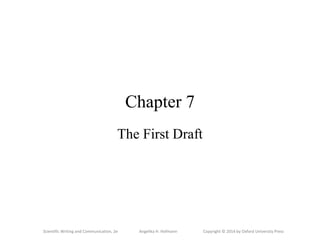More Related Content
More from stanbridge (20)
Ch7
- 1. Scientific Writing and Communication, 2e Angelika H. Hofmann Copyright © 2014 by Oxford University Press
Chapter 7
The First Draft
- 2. Scientific Writing and Communication, 2e Angelika H. Hofmann Copyright © 2014 by Oxford University Press
The Writing Process
Prewriting―decide on the intended audience and journal
Drafting―review literature and start writing
Revising―expect to do multiple revisions with your colleagues
Editing―copyedit for grammar, spelling and punctuation
Evaluating―submit and have manuscript peer-reviewed
Publishing―printed for publication
- 3. Scientific Writing and Communication, 2e Angelika H. Hofmann Copyright © 2014 by Oxford University Press
The Writing Process
Publish
PrewritingPrewriting
DraftDraft
ReviseRevise
EditEdit
EvaluateEvaluate
1. Decide on the
intended audience
and journal
2. Review
literature and
start writing
3. Revise with
your colleagues
4. Copyedit
grammar,
spelling and
punctuation
5. Submit to
peer review
- 4. Scientific Writing and Communication, 2e Angelika H. Hofmann Copyright © 2014 by Oxford University Press
Prewriting
• Search for the best match of topic audience
and journal
• Obtain Instructions for Authors. Follow
them!
• Decide on authorship before starting to
write
- 5. Scientific Writing and Communication, 2e Angelika H. Hofmann Copyright © 2014 by Oxford University Press
Authorship
• Decide before you start writing
Co-author = everyone that contributed
significantly to research or design
• Do not include people that only helped in
writing or in collecting data
• All co-authors should read and approve the
final version
- 6. Scientific Writing and Communication, 2e Angelika H. Hofmann Copyright © 2014 by Oxford University Press
Order of Authorship
Generally,
• First author = contributed the most to the research
• Last author = head of the laboratory
• Corresponding author = did most of the writing and is usually,
the first or last author
• First authors may be in alphabetical order
• Footnotes may indicate % contribution
• All other authors—in the order of their contribution
- 7. Scientific Writing and Communication, 2e Angelika H. Hofmann Copyright © 2014 by Oxford University Press
Drafting
Follow the IMRAD format
Order of core sections of academic research articles
Title page
Abstract
Introduction
Materials and Methods
Results
Discussion
References
- 8. Scientific Writing and Communication, 2e Angelika H. Hofmann Copyright © 2014 by Oxford University Press
Purpose of IMRAD Sections
Section Details
Introduction
Provides context by explaining how the hypothesis was
derived and how it connects to previous research; gives the
purpose of the experiment/study
Methods
Clarifies how you tested the hypothesis and why you
performed your study in that particular way
Results
Explains how the data were evaluated; shows calculations,
expresses the data in table form or as figures where needed
Discussion
Interprets your results and discusses the implications of your
findings; states potential limitations of your experimental
design
- 9. Scientific Writing and Communication, 2e Angelika H. Hofmann Copyright © 2014 by Oxford University Press
Writing the First Draft
• Worry about the writing principles
in the revisions
• Start by writing less
• Collect, study, and organize your
references
• Organize your data and ideas
• Center your writing on the overall
question/purpose of the paper
- 10. Scientific Writing and Communication, 2e Angelika H. Hofmann Copyright © 2014 by Oxford University Press
The First Draft
• Need a block of time
• Write when your energy is high
• Surround yourself with everything you need
• Work in a quiet place
• Tailor the paper to your target journal
• Write the easiest section first and use an outline
if it helps
• Have a native-speaking scientific colleague
comment
- 11. Scientific Writing and Communication, 2e Angelika H. Hofmann Copyright © 2014 by Oxford University Press
The First Draft (cont’d)
• Keep moving
o Worry about writing principles in revisions
o Use abbreviations
o If you draw a blank, leave a space
• Think of each section as a separate task
• Write less
o Introduction: 1 paragraph
o Discussion: 2 paragraphs . . .
- 12. Scientific Writing and Communication, 2e Angelika H. Hofmann Copyright © 2014 by Oxford University Press
Writer’s Block?
To overcome writer’s block:
• Know that you are not alone
• Organize your materials
• Use provided samples
• Use wording of other authors
• Write as if you are explaining your work to a friend
• Write one paragraph at a time
• Set deadlines
• Involve your co-authors
- 13. Scientific Writing and Communication, 2e Angelika H. Hofmann Copyright © 2014 by Oxford University Press
Outside Help
• Hire a scientific editor
• Collect sample phrases for references
• Consult books on scientific/technical writing
